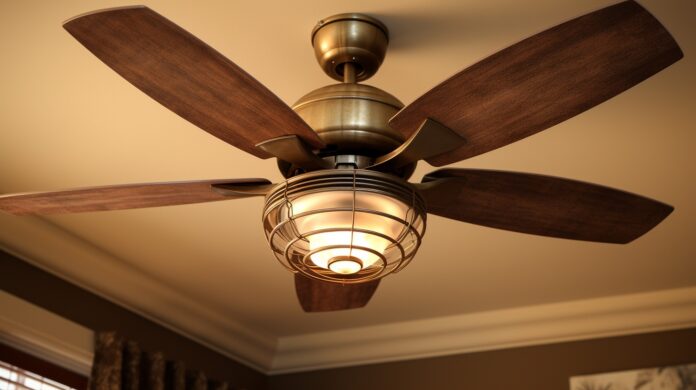You’re sitting in your living room, reading a book or watching TV. The lights on the ceiling fans turn on abruptly, but nobody else is home.
The bad news is that it’s unlikely that your story will be used in the upcoming Ghost Busters film or on the 9 o’clock news. There are actually a number of common causes for this. There are as many answers as there are reasons, which is wonderful news!
Ceiling fan lights turn on by themselves if there is faulty wiring, breaker issues, defective wall switches, power outages, or surges. Remote-controlled celling light could be picking up wireless signals from other devices. Changing the frequency or fixing the breaker, switch, or wiring should fix the issue.
Other Devices Affecting the Light

One explanation for broken fan lights only applies to remote-controlled models.
A fan that has lights and uses wireless signals and has a remote control to operate. It’s likely that the fan’s receiver is catching signals sent by other wireless sources.
Any gadget that relies on wireless signals to function, including Bluetooth devices and wireless internet connections, could be sending signals to the fan.
This may be the issue if you discover that the ceiling fan light comes on whenever you try to activate a Bluetooth speaker or play around with the internet network.
Solution
In this case, the solution is to reset the frequency of the ceiling fan remote.
- Disconnect the power.
- To reach the receiver, remove the canopy from the ceiling fan.
- There will be four DIP switches on the receiver somewhere. These need to resemble four little buttons that may be moved up and down to form a special combination. To get to these, you might have to take a panel off the receiver.
- To alter the frequency of the fan, move the buttons into new locations.
- The four DIP switches are located here; remove the batteries from the remote. They might also be hidden by a tiny panel beneath the batteries.
- Adjust the remote DIP switches to match the receiver’s frequency (pattern).
Hopefully, you have now altered the frequency of your ceiling fan to one that is not being utilized by other devices in your home.
You Are Detecting the Signal from Your Neighbor
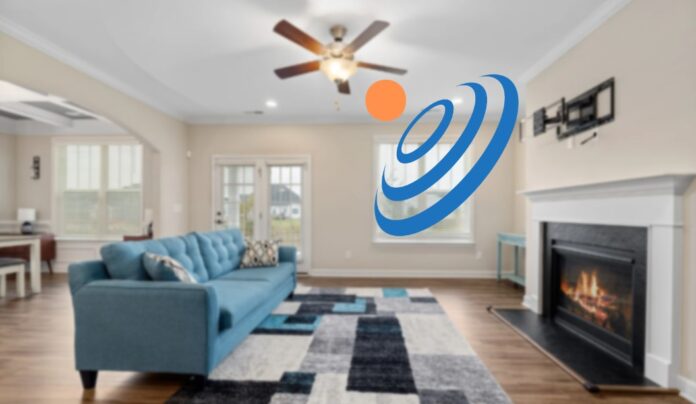
Similar to the previous explanation, your fan might be picking up signals from your neighbor’s remote if you both own the same brand and type of remote-controlled fan.
Despite the fact that there are only four DIP switches, there are certain ceiling fans of various brands that can run on the same frequency as your fan.
Either you are paying them back by using your remote to switch on and off their lights, or they have a stronger remote that sends the signal to your receiver.
You might ask your neighbor to assist you in testing this notion. If they try turning on their fan from their home, you can see if the fan in your home turns on at the same time.
Solution
If this is the reason your light is turning on by itself, the solution would, again, be to reset the frequency of the ceiling fan’s remote.
Power Surges
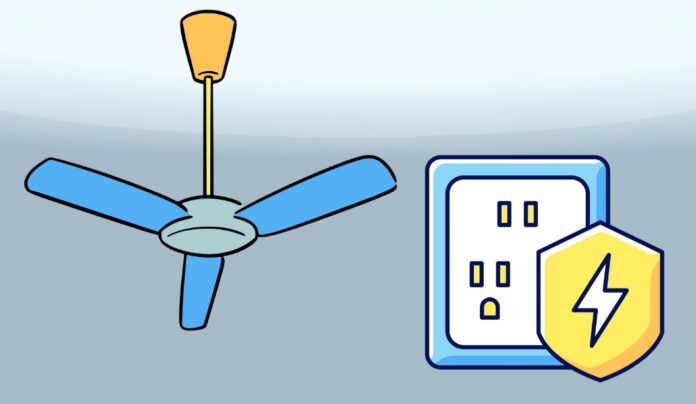
A power surge could cause the ceiling fan light to automatically switch on. Both non-remote-controlled and remote-controlled fans may experience this.
A power surge can happen for many reasons, but ultimately it results in a surge of electricity rushing through a circuit, which could reach your ceiling fan light (despite it being “off”).
If this is the cause of your ceiling fan light going on by itself, it probably will only have a temporary impact. In other words, the light will flash on and then off as the surge passes or the circuit strips.
Power surges can range in strength, and the harm they do is worse as the extra current rises. You should check the circuit and device for damage because not all power surges will automatically switch on your ceiling fan light and those that do are likely to be more intense.
In addition to your ceiling fan light turning on by itself, other signs of a power surge include unusual odors near power outlets, other devices working improperly, and issues with other lights flickering or turning on/off.
Solution
Wiring damage is the most prevalent cause of frequent power surges. It is vital to get in touch with an electrician to conduct an examination if you experience them because it might be risky to look into them and attempt to remedy them on your own.
A specialist can evaluate the circumstance and make recommendations for the following actions. They can range from almost no maintenance (just unplugging a faulty low-quality gadget) to minor or major repairs. That all depends on your particular circumstance.
Power surges can also be caused by lightning striking the house or an issue with the grid supply to your home. If these are the cause, then a professional is still your best resource.
Power Outage
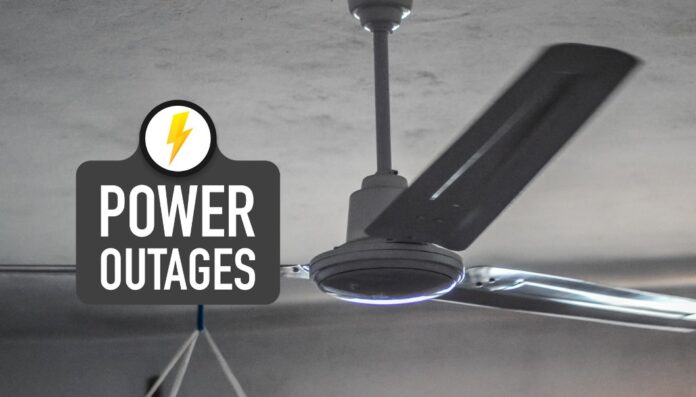
A smart lightbulb might be used in the ceiling fan light. They are wired and furnished with a battery, enabling them to work even when the circuit is not receiving electricity. Additionally, they are made to switch on automatically the moment your home’s electricity is restored.
This feature is built in because if the bulb was turned off using a remote or app before the power outage, and someone flipped the manual switch a few times while the power was off, then it can mess with the on/off settings. So, the light comes on automatically, and you can turn it off, “resetting” the on/off switches, as it were.
As the electricity is restored after a power outage, there could be a surge in power. Whether or not you have a smart bulb, this can also be a problem as electricity might surge rapidly when the power is restored.
Solution
The web application of certain smart lights may contain a feature that lets you specify the settings you want the lights to have when the power is restored, including staying off.
Sadly, not all smart bulbs will have these features, therefore you will need to find out if your particular brand can perform these functions.
If you cannot program the bulb to stay off or turn it off again after power is restored, then you will just have to manually turn it off unless you wish to replace it with a model that can be programmed.
Wiring Problems
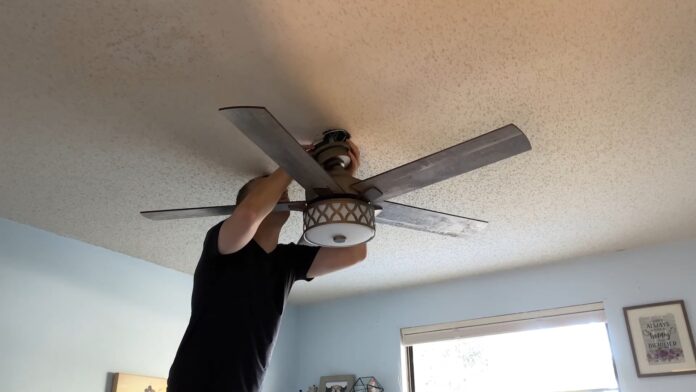
Any ceiling fan may have faulty wiring as a problem. It may occasionally be the result of poor installation. The voltage will flow through the wiring at an erratic rate as a result, resulting in the light coming on by itself.
You can check the wiring that connects to the ceiling fan and search for any flaws, such as tearing or damage, to see if this is the issue. The best-case scenario is that you will only discover a few loose connections that require tightening.
Solution
Repairing damaged wiring ought to be your first concern because it may result in an electrical fire. You have two options: either try to fix it yourself or hire an electrician to do it.
In the US, the average cost of employing an electrician to replace wiring is $1,375. Depending on the area of the wiring that needs to be replaced, how long the project takes, etc., this can change dramatically.
There are numerous things to think about if you choose to fix the wiring yourself. You will need to figure out how you will access the wiring, what supplies you will need, what codes you need to follow, and more.
It is highly recommended that thorough research be done before attempting this yourself, as there are dangers that come with working on electrical structures.
Your research should also extend to whether or not you are permitted to do your own wiring. In some areas, it is against the law for an unlicensed person to perform electrical work.
Defective Wall Switch

Any ceiling fan can experience problems with a light wall switch, especially those that aren’t remote-controlled. Wall switches may become loose as a result of their frequent use.
This is likely the issue if:
- The light doesn’t work when using the switch.
- The switch turns on by itself.
- You notice changing between the on and off switch positions is difficult.
- The switch doesn’t stay in the position you set.
Solution
If the wall switch is the source of the issue, you can examine it and replace it if necessary.
Testing the switch:
- First, it’s important to shut off the circuit breaker.
- Then, remove all coverings from the external wall fixture.
- Use a voltage tester on the terminals and make sure it reads zero before handling wiring.
- If it’s safe, you can check whether the wires on the switch are loose and tighten them if needed.
- Then, turn the power on and test the switch again.
- If this doesn’t work, turn the power off, try connecting both wires to one screw, turn the power back on, and see if the light comes on. If it does, the switch needs to be replaced.
To replace the switch:
- Ensure the power is off and prepare the new switch.
- Loosen all screws and connect the wires to the new switch.
- Then, put everything back and test it.
Using caution and following the manufacturer’s directions should be used here. It is advisable to learn more about the equipment you have.
Issues With the Circuit Breaker
Another potential cause of the ceiling fan light going on by itself is a malfunctioning circuit breaker. A burning odor, appliances that trip at random, or a hot breaker are some indications that this is what is happening.
It is recommended to get a qualified electrician to come in and evaluate the problem if there are any indications that the circuit may be burning.
Solution
If there aren’t any serious signs, there are a few things you can do to troubleshoot the circuit breaker yourself.
You can start by switching the circuit breaker back and forth between on and off. Be sure to wait a few minutes in between flipping the switch off and on.
If this doesn’t work, check the wiring around the circuit breaker and look for any loose connections. Those are especially common for issues with lights.
Finally, check the circuit itself to make sure there aren’t too many things connected to it. You may need to move around some things if the circuit is overloaded.
Malfunctioning LED Light Bulb
If your fan uses LED light bulbs, the LED bulb itself might be malfunctioning. Most likely, the bulb is receiving more power than it needs.
LED bulbs don’t require very much power to work, so in some rare cases, if it is receiving too much power, the bulb may glow even if the light is technically off.
Solution
Since an LED bulb can be harmed by receiving too much electricity, this is a problem that needs to be solved. In addition, it is a waste of energy.
To fix this issue, you will simply need to connect the LED bulb to a lower amount of amps than it is currently attached to.
FAQ
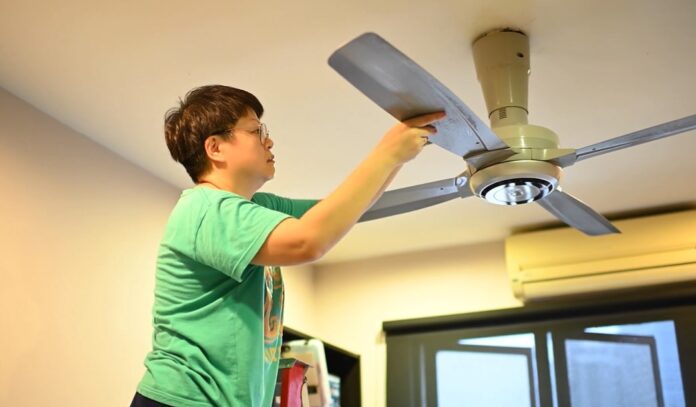
Why Does My Ceiling Fan Change Direction by Itself?
Although it is not a frequent issue, a switch that is wired improperly is typically to blame. The fan may start spinning in the opposite direction from what you intended. To fix this problem, you would need to redo the switch.
Why Do Appliances Turn on By Themselves?
When there is an electrical problem, it is not uncommon for appliances to turn on by themselves. The appliance’s electrical parts may be to blame for this. It’s recommended that you turn off appliances when you are not home and unplug them when you leave.
Can a Light Switch Flip Off by Itself?
A switch could accidentally turn off by itself. This frequently happens when there is a wiring issue. If you notice this occurring in your house, be sure to contact a specialist who can identify the problem.
Can a Ceiling Fan Warm Your Home?
During winter, you can warm your home with a ceiling fan by running it in a clockwise direction. This will push the hot air that’s trapped near your ceiling down to where it can warm you and your family.
Finale Words
While the sudden activation of your ceiling fan light might initially seem like a scene from a supernatural thriller, the reality is far more mundane. There are numerous reasons for this phenomenon, ranging from faulty wiring, interference from other wireless devices, power surges, to malfunctioning LED bulbs.
Each cause has its own set of solutions, whether it’s resetting the frequency of a remote, consulting with an electrician, or simply replacing a defective switch.
It’s essential to diagnose the root cause accurately to ensure safety and proper functioning. Additionally, while ceiling fans primarily serve to circulate air, they can also aid in warming your home during colder months.
Always prioritize safety, and when in doubt, seek professional advice

